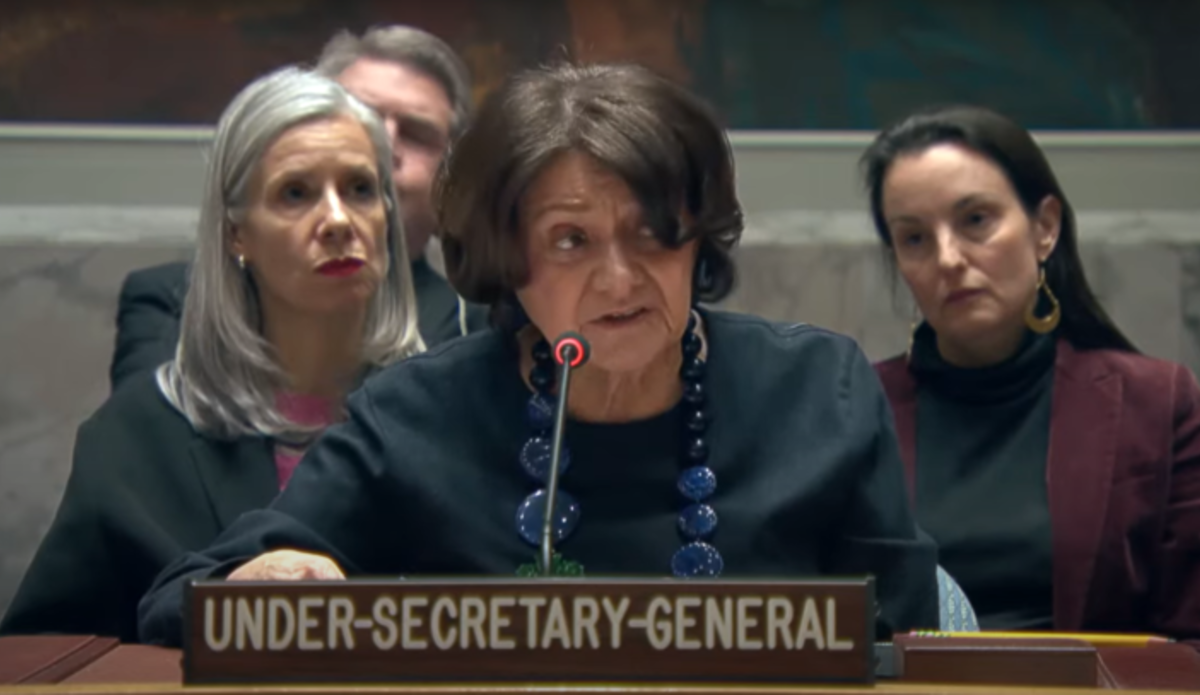Under-Secretary-General Rosemary A. DiCarlo
Briefing to the Security Council on the
Threats to International Peace and Security
New York, 5 February 2024
Thank you, Madam President.
As we are all too aware, the tensions that have engulfed multiple countries in the Middle East continue to rise. Tragically, this comes as no surprise. The Secretary-General has repeatedly warned about the risks of further escalation and miscalculation in the region since the horrific Hamas attacks on Israel on 7 October and the devastating Israeli counteroffensive in Gaza.
Since mid-October 2023, we have witnessed near daily incidents in the region. These include some 165 attacks on United States facilities in Syria and Iraq, prompting US strikes in the two countries.
Then, on 28 January, a drone attack killed three US service members and injured 40 at a US base known as “Tower 22,” in northeast Jordan, near al-Tanf base in Syria. On 2 February, the US Central Command said it had carried out 85 airstrikes in Iraq and Syria against reported Iranian Islamic Revolutionary Guards Corps (IRGC) Quds Forces and affiliated groups.
Syria and Iraq condemned the 2 February strikes, with both governments claiming they had resulted in deaths and injured civilians. The US said it had targeted command and control operations, intelligence centers and weapons facilities, among other sites, and that it was not seeking conflict in the Middle East or elsewhere.
While the Iraqi Government has continued to repeat its commitment to protecting US and coalition forces inside Iraq, some armed factions linked to the “Islamic Resistance in Iraq” have pledged to continue their attacks against US and coalition forces in the region.
Madam President,
The wave of violence since early October involves a large swath of the Middle East. The Israel Defense Forces and Hezbollah, along with other non-State armed groups in Lebanon, have exchanged fire across the Blue Line on an almost daily basis since 8 October.
There has been repeated rocket fire over the occupied Golan between Israel and militias reportedly linked to Iran, as well as airstrikes attributed to Israel by the Government of Syria on multiple locations in Syria.
Ongoing Houthi drone and missile attacks and threats to navigation in the Red Sea are deeply worrying and risk both exacerbating the conflict and further impacting international trade, as companies divert ships away from critical maritime routes.
A report on Houthi attacks on merchant and commercial vessels in the Red Sea will be shortly before the Council in accordance with resolution 2722 (2024).
Since 11 January, the United States and the United Kingdom, with the backing of six other member states, have launched strikes on Houthi positions in Yemen.
They have occurred consecutively over the last three days. More than 36 targets across 13 locations were reportedly struck on 3 February, including what was described as underground storage facilities, command and control sites, missile systems, UAV storage and operations sites, radars, and helicopters.
An additional missile launch site was reportedly hit on 4 February. Today, sites in Hudaydah were also targeted, including some very close to United Nations offices on the ground.
Madam President,
I reiterate the Secretary-General’s call on all parties to step back from the brink and to consider the unbearable human and economic cost of a potential regional conflict.
It has been nearly four months since more than 1,200 Israelis were killed in the attacks by Hamas, with over 250 people taken hostage.
As the Secretary-General said, this has been a period of heartache and anguish for Israelis. I echo the Secretary-General’s call for the immediate and unconditional release of all the hostages.
The past four months have also been heartbreaking and catastrophic for Palestinians civilians in Gaza, where hunger is rampant, disease is spreading and shelter is squalid at best for a vast number of people.
The death toll in the Strip is reported to have surpassed 27,000, mostly women and children. Thousands more are reported missing. The civilian population of Gaza should not pay for the terror unleashed by Hamas.
I reiterate the Secretary-General’s call for an immediate humanitarian ceasefire in Gaza.
The risk of escalation in the Middle East, and its potential consequences, was obvious from 7 October.
A quick survey of the agenda of this Council explains why: The UN is supporting political and peace processes throughout the region, in countries emerging, or still suffering, from armed conflict.
The Middle East remains highly volatile. Long-term regional stability demands the implementation of a clear political roadmap in each of these situations.
The Secretary-General continues his extensive outreach to all key stakeholders to urge all parties to take concrete measures to de-escalate tensions, and to work towards sustainable political solutions that aim to resolve, rather than merely manage, longstanding conflicts.
I appeal to the Council to continue to actively engage all concerned parties to prevent further escalation and the worsening of tensions that undermine regional peace and security.
Thank you, Madam President.

